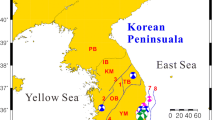Abstract
The drilling strain observation techniques have been played a very important role in the research field of geodynamics and earthquake prediction, and have been gotten wide applications. We have achieved a number of observational solid tide data from the station without the influence and interference from ground. The apparatus could record clear and stable solid tide and strain wave with coseism. Through the solid tide model of Nakai, we calculated and gained solid tide proportion factors in the directions of deepwell, from deepwell strain observation, to verify that the tide response to the theoretical tidal factor model in Baishan station is a very large dispersion and a regular azimuthal anisotropy. The high precision deepwell solid tide observation and tidal response anisotropy phenomenon is expected to be on the dynamics, earthquake prediction, to provide a reference to improve the tide displacements of observation data in space geodesy.
Access this chapter
Tax calculation will be finalised at checkout
Purchases are for personal use only
Similar content being viewed by others
References
Chi, S.L., Wu, H.L., Luo, M.J.: Discussion on strain tidal factor separation and anisotropy—analysis of first data of borehole component strain-meter of China’s digital seismological observational networks. Prog. Geophys. 22(6), 1746–1753 (2007). (in Chinese)
Nakai, S.: Pre-processing of tidal data. BIM 76, 4334–4340 (1977)
Jiang, Z., Zhang, Y.B.: A differential analytical-representation of the theoretical value of earth tide and the fit-testing of earth tide data. Acta Geophysica Siniva 37(6), 776–786 (1994). (in Chinese)
Zhang, Y.B.: Applicatlon of numerical differential in Nakai process of tidal data. Crustal Deform. Earthq. 9(4), 79–83 (1989). (in Chinese)
Tang, J.A.: The zenith distance formulas of the first order differential quotient for the theoretic value of the earth tides applied to the fit-testing of the gravity, tilter and line strain earth tides. Crustal Deform. Earthq. 10(2), 1–8 (1990). (in Chinese)
Feng, K., Zhang, J.Z., Zhang, Q.X.: Numerical Computing Methods. Defense Industry Press, Beijing (1978). (in Chinese)
Acknowledgment
This work is supported by projects of Spark Program of Earthquake Science and Technology (XH16003), Three Combination of China Earthquake Administration(CEA-JC/3JH-170203) and National Natural Science Foundation (NNSF) of China under Grant 41474087.
Author information
Authors and Affiliations
Corresponding author
Editor information
Editors and Affiliations
Rights and permissions
Copyright information
© 2019 Springer Nature Switzerland AG
About this paper
Cite this paper
Wu, A. (2019). Anisotropy of Earth Tide from Deepwell Strain. In: Xiong, N., Xiao, Z., Tong, Z., Du, J., Wang, L., Li, M. (eds) Advances in Computational Science and Computing. ISCSC 2018 2018. Advances in Intelligent Systems and Computing, vol 877. Springer, Cham. https://doi.org/10.1007/978-3-030-02116-0_13
Download citation
DOI: https://doi.org/10.1007/978-3-030-02116-0_13
Published:
Publisher Name: Springer, Cham
Print ISBN: 978-3-030-02115-3
Online ISBN: 978-3-030-02116-0
eBook Packages: Intelligent Technologies and RoboticsIntelligent Technologies and Robotics (R0)




